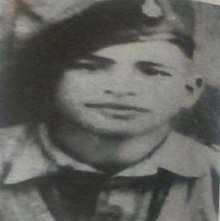Jaswant Singh Rawat
Rifleman Jaswant Singh Rawat, MVC (19 August 1941 – 17 November 1962) was an Indian Army soldier serving in the Garhwal Rifles who won the Maha Vir Chakra posthumously as a result of his actions during the battle of Nuranang in present-day Arunachal Pradesh, India, during the Sino-Indian War. He was honoured by Mahavir Chakra.[1]
Jaswant Singh Rawat | |
|---|---|
 Army headshot of Rawat from the 1960s | |
| Birth name | Jaswant Singh Rawat |
| Born | 19 August 1941 Baryun, British Garhwal District, United Provinces, British Indian Empire (present-day Pauri Garhwal District, Uttarakhand, India) |
| Died | 17 November 1962 (Aged 21) Nuranang, North-East Frontier Agency, India (present-day Arunachal Pradesh, India) |
| Allegiance | |
| Service/ | |
| Years of service | 1 |
| Rank | Rifleman |
| Unit | 4th Garhwal Rifles |
| Battles/wars | Sino-Indian War |
| Awards | |
Sino-Indian War
Rifleman Jaswant Singh Rawat was serving in the 4th battalion, 4th Garhwal Rifles on 17 November 1962 during the Battle of Nuranang, in the North-East Frontier Agency (now Arunachal Pradesh). On that day, the 4th Garhwal Rifles had beaten back two Chinese PLA charges on their position. During a third intrusion, a Chinese medium machine gun (MMG) had come close to the Indian defenses and was firing accurately at their positions. Rifleman Jaswant Singh Rawat, along with Lance Naik Trilok Singh Negi and Rifleman Gopal Singh Gusain volunteered to subdue the MMG.
Rawat and Gusain, aided by covering fire from Negi closed within a grenade-throwing distance of the machine gun position and neutralized the Chinese detachment of five sentries, seizing the MMG in the process. However, while returning, Gusain and Negi lost their lives and Rawat was seriously injured, although he managed to return with the captured weapon. The battle resulted in 300 Chinese casualties, whereas the 4th Garhwal Rifles lost two men and had eight wounded.[2]
The bravery shown by Jaswant Rawat was honored by building a memorial at the post where he fended off the People's Liberation Army but lost. The post which he held was named "Jaswant Garh".[3][4] Another honor bestowed upon him is that he continues to serve even after death; he has been awarded promotions as if he is still serving.[5]
4th Garhwal Rifles was later awarded the Battle Honour Nuranang, the only battle honor awarded to an army unit during the war.[6]
In popular culture
The Hindi movie 72 Hours: Martyr Who Never Died, directed by Avinash Dhyani, is based on the story of Rifleman Jaswant Singh Rawat.[7]
References
- "72 Hours: A Movie On Jaswant Singh, The Man Who Saved Arunachal Pradesh From The Chinese". IndiaTimes. 13 April 2016. Retrieved 12 July 2020.
- Col J Francis (Retd) (30 August 2013). Short Stories from the History of the Indian Army Since August 1947. Vij Books India Pvt Ltd. p. 53. ISBN 9789382652175.
- Pisharoty, Sangeeta Barooah. "When It Comes to Renaming Places in Tawang, China Is Not Alone". thewire.in. Retrieved 6 June 2017.
- M Panging Pao (22 December 2019). "Heroes of 1962 War in Arunachal, Battle of Nuranang".
- Talbot, Ian (2016). A History of Modern South Asia: Politics, States, Diasporas. Yale University Press. ISBN 0300216599.
- Singh Gp Capt, Ranbir (2009). Memorable War Stories. Prabhat Prakashan. p. 27. ISBN 8188322660.
- Pioneer, The. "72 Hours...movie on the legendary solider to be released on Friday". The Pioneer. Retrieved 11 June 2020.